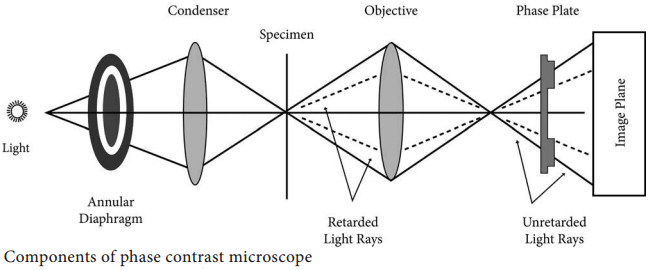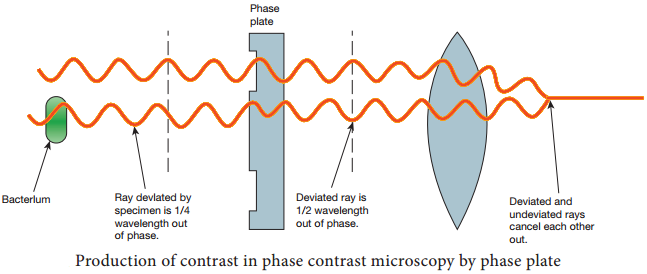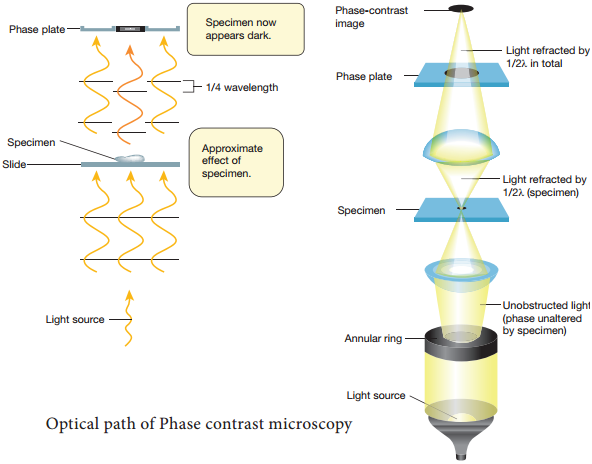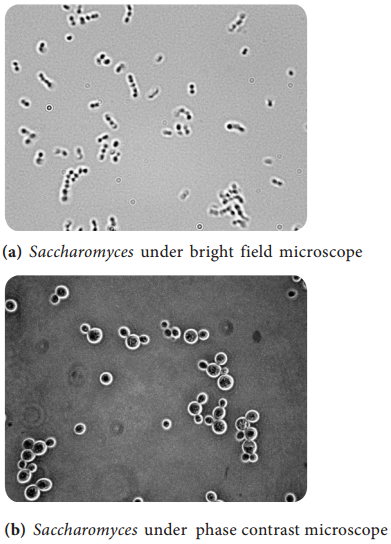Learninsta presents the core concepts of Microbiology with high-quality research papers and topical review articles.
Phase Contrast Microscope – Definition, Principle, Parts, Uses
Frits Zernike a Dutch Physicist invented the Phase Contrast Microscope and was awarded Nobel Prize in 1953. It is the microscope which allows the observation of living cell. This microscopy uses special optical components to exploit fine differences in the refractive indices of water and cytoplasmic components of living cells to produce contrast.

Principle
The phase contrast microscopy is based on the principle that small phase changes in the light rays, induced by differences in the thickness and refractive index of the different parts of an object, can be transformed into differences in brightness or light intensity. The phase changes are not detectable to human eye whereas the brightness or light intensity can be easily detected.
Optical Components of Phase Contrast Microscope (PCM)
The phase contrast microscope is similar to an ordinary compound microscope in its optical components. It possesses a light source, condenser system, objective lens system and ocular lens system (Figure 2.1).
A phase contrast microscope differs from bright field microscope in having,
(i) Sub-stage annular diaphragm (phase condenser):-
An annular aperture in the diaphragm is placed in the focal plane of the sub-stage which controls the illumination of the object. This is located below the condenser of the
microscope. This annular diaphragm helps to create a narrow, hollow cone of light to illuminate the object.
(ii) Phase – plate (diffraction plate or phase retardation plate):-
This plate is located at the back focal plane of the objective lenses. The phase plate has two portions, in which one is coated with light retarding material (Magnesium fluoride) and the other portion devoid of light retarding material but can absorb light. This plate helps to reduce the phase of the incident light (Figure 2.2).

Working Mechanism of Phase Contrast Microscopy
The unstained cells cannot create contrast under the normal microscope. However, when the light passes through an unstained cell, it encounters regions in the cell with different refractive indexes and thickness. When light rays pass through an area of high refractive index, it deviates from its normal path and such light
rays experience phase change or phase retardation (deviation). Light rays pass through the area of less refractive index remain non-deviated (no phase change). Figure 2.3 shows the light path in phase contrast microscope.

The difference in the phases between the retarded (deviated) and un-retarded (non-deviated) light rays is about ¼ of original wave length (i.e., λ/4). Human eyes cannot detect these minute changes in the phase of light. The phase contrast microscope has special devices such as annular diaphragm and phase plate, which convert these minute phase changes into brightness (amplitude) changes, so that a contrast difference can be created in the final image. This contrast difference can be easily detected by human eyes.
In phase contrast microscope, to get contrast, the diffracted waves have to be separated from the direct waves. This separation is achieved by the sub-stage annular diaphragm.
The annular diaphragm illuminates the specimen with a hollow cone of light. Some rays (direct rays) pass through the thinner region of the specimen and do not undergo any deviation and they directly enter into the objective lens. The light rays passing through the denser region of the specimen get regarded and they
run with a delayed phase than the nondeviated rays.
Both the deviated and non deviated light has to pass through the phase plate kept on the back focal plane
of the objective to form the final image. The difference in phase (Wavelength) gives the contrast for clear visibility of the object. Figure 2.4 Microscopic image comparing phase and bright field microscopy.

Applications (Uses)
- Phase contrast microscope enables the visualization of unstained living cells.
- It makes highly transparent objects more visible.
- It is used to examine various intracellular components of living cells at relatively high resolution.
- It helps in studying cellular events such as cell division.
- It is used to visualize all types of cellular movements such as chromosomal and flagellar movements.